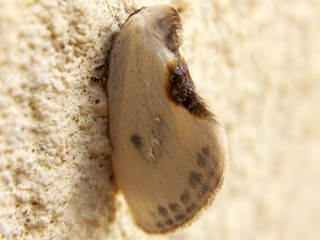Cilix was, according to Greek mythology, a Phoenician prince as the son of King Agenor and Telephassa or Argiope.

Salvia hispanica, commonly known as chia, is a species of flowering plant in the mint family, Lamiaceae, native to central and southern Mexico and Guatemala. It is considered a pseudocereal, cultivated for its edible, hydrophilic chia seed, grown and commonly used as food in several countries of western South America, western Mexico, and the southwestern United States.

Drepaninae are by far the largest subfamily of the Drepanidae moths. While it is usually split into two tribes, Drepanini and Oretini, its internal systematics and phylogeny are not well resolved.

Cilix glaucata, the Chinese character, is a moth of the family Drepanidae. It was first described by the Italian physician and naturalist, Giovanni Antonio Scopoli in his 1763 Entomologia Carniolica. It is found in Europe, Asia Minor and North Africa.

Halspiviridae is a family of viruses that consists of a single genus, Salterprovirus, which consists of a single recognised species; Salterprovirus His1. This virus was isolated from hypersaline water in Australia and was able to be cultured on the halophilic archaeon Haloarcula hispanica. Like many other archaeoviruses, His1 has an approximately limoniform (lemon-shaped) virion.

Cilix is a genus of moths belonging to the subfamily Drepaninae. The genus was erected by Leach in 1815.
Elachista hispanica is a moth of the family Elachistidae that is endemic to Spain.

The Beautiful Gothic(Leucochlaena oditis) is a Palearctic moth of the family Noctuidae, sub-family Cuculliinae. It is found in southern Europe and north Africa, with occasional finds on the southern coast of England.

Cilix asiatica is a moth in the family Drepanidae first described by Otto Bang-Haas in 1907. It is found in Ukraine, Romania, Bulgaria, North Macedonia, Greece, Crete, the eastern parts of Turkey, Israel and Lebanon. The habitat consists of xerothermic woodland.
Cilix depalpata is a moth in the family Drepanidae first described by Strand in 1911. It is found in Afghanistan and Pakistan.
Cilix algirica is a moth in the family Drepanidae described by Patrice J.A. Leraut in 2006. It is found in Morocco, Algeria and possibly Portugal.
Alphasphaerolipovirus is a genus of double stranded DNA viruses that infect haloarchaea. The genus contains four species.
Nemapogon hispanica is a moth of the family Tineidae. It is found in Spain.
Cilix danieli is a moth in the family Drepanidae first described by Watson in 1968. It is found in Shanxi, China.
Cilix filipjevi is a moth in the family Drepanidae first described by Nikolai Ivanovich Kardakoff in 1928. It is found in the Russian Far East (Ussuri), Korea, north-eastern China and Japan.
Cilix patula is a moth in the family Drepanidae first described by Watson in 1968. It is found in Yunnan, China.
Cilix tatsienluica is a moth in the family Drepanidae first described by Oberthür in 1916. It is found in China.
Cilix argenta is a moth in the family Drepanidae. It is found in China.
Cilix is a small crater on Europa that serves as the reference point for the moon's system of longitude. The longitude of Cilix's center is defined as being 182° W, thus establishing the moon's prime meridian. It is named after Cilix, the brother of Europa








